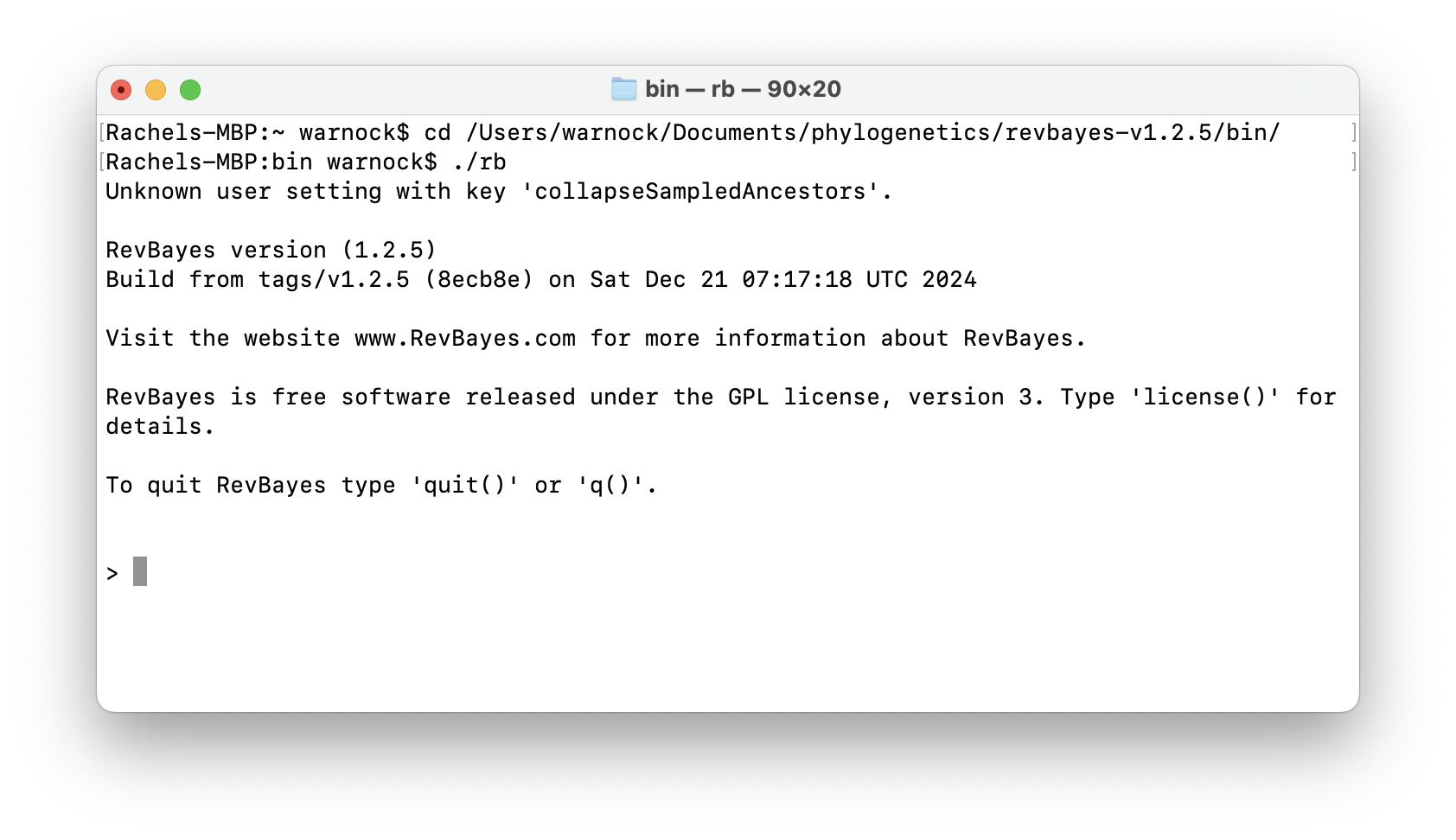Introduction to RevBayes and the Rev language
RevBayes is a flexible program that has been developed for Bayesian phylogenetics. It has it’s own command line language, similar to the R programming language, that can be used to set up a model in a Bayesian framework. We won’t run any analyses in this exercise, we’ll just explore the Rev language and look at the syntax used to set up different types of variables.
Running RevBayes
First make sure you can download and install the
software. We recommend running RevBayes in the terminal (or GitBash if
using windows). There are a few ways to do this but perhaps the easiest
way is to change working directory or cd to where the
RevBayes executable is on your computer. From there you can open
RevBayes using ./rb. You might have to navigate to your
security settings to enable RevBayes to run on your device. It should
look something like this:

Ready to go! Reach out to an instructor if you encounter any issues.
Once you have it up and running, see if you can produce any sensible output using the RevBayes terminal. For example, it can be used like a calculator in the same way as R.
4 + 10Constant variables
Constant variables have a fixed value and are specified using the
left arrow <- assignment.
a <- 4
b <- 10
a + bNote that in R the = and <- assignment
can almost always be used interchangeably. This is not the case in
RevBayes, where = can be used to define variables in your
environment, but these can’t then be used as part of a model. We’ll see
some examples of when we might use = in RevBayes in future
weeks.
To clear the value of a variable you can use
clear(a).
Deterministic variables
Deterministic variables are linked to the value of other variables
and specified using the colon-equal := assignment.
# specify constant variable "a"
a <- 4
# specify deterministic variable "b"
b := a
b# now see what happens if you change the value of "a"
a <- 5
bDeterministic variables can also be transformed using any given formula you provide.
b := 3 * aExplore what happens when you change the value of
aand experiment with different formulas / operators.
Stochastic variables
Stochastic variables are described with respect to some underlying
probability distribution and are specified using the tilde
~ assignment. For example, we might want to say that
variable c is a normally distributed random variable.
# specify the mean and standard deviation parameters as constant variables
a <- 1
b <- 0.1
# specify a stochastic variable using the normal distribution
c ~ dnNormal(a, b)
cAny distribution function in Rev always begins with dn.
You can also bring up help pages using a question mark like we do in R,
e.g., ?dnNormal will bring up help pages for the normal
distribution.
You can define stochastic variables in RevBayes using any common statistical distributions (as well as more complex phylogenetic distributions that we’ll meet in future weeks). A list of available Rev functions can be found here.
Can you think of any other common distributions and try to set them up in RevBayes?
If you run the above code again, c will take on a
different random value from the normal distribution. Without more
context, it might not seem obvious why we’d want to define a variable in
this way. You can think of c as a potential parameter with
an unknown value that we’re interested in estimating. When we go on to
set up the full analysis in a later class, you’ll see that we can update
the value of c during our analysis. And because stochastic
variables like c are linked to an underlying distribution,
c inherits some of the properties of that distribution. We
can call functions related to that distribution by using .
followed by a function name. For example, c.probability()
will tell us the probability of observing the current value of
c given the underlying distribution.
Redefine your stochastic variable and compare the probability for different values under the same distribution – do these probabilities make sense to you?
Functions
A substitution model is defined by an instantaneous rate matrix,
where each character transition is associated with a rate of change
(e.g., the rate of changing from A to G). We could set this up manually,
by specifying an entry for each row/column in a matrix but this is a
kerfuffle. Luckily, RevBayes has many inbuilt functions, which begin
fn, including one for all the most commonly used
substitution models.
The simplest substitution model for nucleotide data is the
Jukes-Cantor model, which can be specified using the fnJC
function.
# specify a constant matrix variable
Q <- fnJC(4) # 4 here refers to the number of states (i.e. ATGC)
QIn this model all the substitution rates are equal. If substitution
rates vary, we need to estimate this variability from the data and
Q would become a deterministic variable. We’ll see some
examples of this later.
Last thing for today - let’s compare the Q matrix and the transition probabilities over different intervals of time. We can start by creating a simpler 2-state Q matrix.
# specify a constant matrix variable
Q <- fnJC(2)
Q
# calculate the transition probabilities after 0.1 units of time
Q.getTransitionProbabilities(0.1)
# calculate the transition probabilities after 100 units of time
Q.getTransitionProbabilities(100) # 100 unitsOther useful commands
# Change working directory
setwd("/Users/warnock/Documents/phylogenetics/exercise_03")
# To find the current working directory
getwd()
# to exit RevBayes
q()It’s sometimes useful to know how to clear the working memory in RevBayes, e.g., to avoid redefining variables.
# clear working memory
clear()Further reading
Here’s a more comprehensive intro to the Rev language.